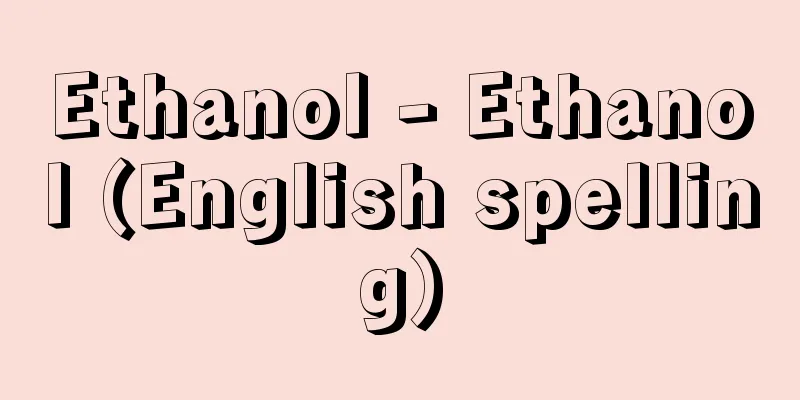Ethanol - Ethanol (English spelling)

|
Organic compounds in which the hydrogen atoms of hydrocarbons are replaced with hydroxyl groups -OH are collectively called alcohols, and are represented by the general formula R-OH. Ethanol is a typical example, and in the narrow sense, the term "alcohol" often refers simply to ethanol. It has been known since ancient times, and is contained in many alcoholic beverages, and is also called spirit or ethyl alcohol. It was not until the 15th century that it was discovered that ethanol is the cause of drunkenness. Its composition was measured by Lavoisier and others, and confirmed by Gay-Lussac and others. [Tokumaru Katsumi] natureIt is a colorless liquid with a distinctive odor and taste. It is miscible in any ratio with water, other alcohols, and many organic solvents such as chloroform and ether. However, when it is mixed with water, it is not possible to obtain pure ethanol by distillation, even though ethanol has a boiling point more than 20°C lower than that of water. Instead, an azeotropic mixture consisting of 96.0% ethanol and 4.0% water is obtained. To obtain anhydrous ethanol from this, it is either added with a suitable dehydrating agent or distilled by adding benzene and utilizing the azeotropic phenomenon between benzene and water. It is highly flammable and produces a colorless flame when ignited. It can also explode if the vapor ignites. When oxidized, it becomes acetaldehyde and then acetic acid. It has a bactericidal effect because it has the ability to coagulate proteins, and its effectiveness is highest when used in a 70% aqueous solution. In nature, it exists in the form of ethyl esters of carboxylic acids, and rarely exists in the form of free ethanol. [Tokumaru Katsumi] Manufacturing methodIt has long been produced by fermenting starch and sugar with yeast, and even today most alcoholic beverages consumed are produced this way. However, with the fermentation method, half of the carbon in the raw sugar is wasted as carbon dioxide, and the price of the raw material fluctuates, so the synthetic method using ethylene obtained from petroleum as the raw material has become widely used. One synthesis method is to absorb ethylene into sulfuric acid to produce the sulfate ester of ethanol, which is then hydrolyzed to obtain ethanol together with diethyl ether (sulfuric acid hydration method). This method is efficient in that 96% of the raw ethylene is converted into ethanol and diethyl ether, but has the problem of using a large amount of sulfuric acid. Instead, a method has come into use in which ethylene is catalytically reacted with steam over a solid phosphoric acid catalyst in the gas phase to directly synthesize ethanol (direct hydration method). The equilibrium for ethanol production from ethylene and steam is favored by higher pressures and lower temperatures, so the reaction is carried out at around 70 atmospheres and 300°C. [Tokumaru Katsumi] ApplicationsAlcoholic beverages contain ethanol and are used as beverages. For example, sake usually contains 15-16% ethanol, beer 3-8%, wine 7-14%, and distilled alcoholic beverages such as whiskey and brandy 35-55% ethanol. Ethanol was once used as a raw material for synthesizing acetaldehyde and then acetic acid, but this method has now been replaced by the direct hydration method from ethylene. Currently, ethanol is used as a raw material for ethyl acetate, a solvent, or as a solvent itself. In addition, since industrial alcohol is tax-free while drinking alcohol is taxed, to distinguish between the two, small amounts of highly toxic methanol (methyl alcohol) are added to industrial alcohol to make it denatured and prevent it from being used as a drink. [Tokumaru Katsumi] PharmaceuticalThe Japanese Pharmacopoeia lists three types of ethanol: ethanol, absolute ethanol, and disinfectant ethanol. Ethanol has a concentration of 95.1-95.6%, while absolute ethanol is 99.5% or more. It is used as an extractant or solvent for tinctures, spirits, elixirs, extracts, and liquid extracts. Absolute ethanol is injected to block nerves (nerve blocks) for severe pain that painkillers do not relieve, such as trigeminal neuralgia or terminal cancer. Disinfectant ethanol is made by diluting the first two with purified water to 76.9-81.4%, and is often used to disinfect the skin of hands and injection sites. It can also be applied as a skin irritant to prevent bedsores. It is not suitable for disinfecting instruments. [Fumiji Koho] [References] | | | [Supplementary information] |©Shogakukan "> Ethanol synthesis (direct hydration method) Source: Shogakukan Encyclopedia Nipponica About Encyclopedia Nipponica Information | Legend |
|
炭化水素の水素原子をヒドロキシ基-OHで置換した有機化合物をアルコール(類)と総称し、一般式R-OHで示される。エタノールはその代表的なもので、狭義では単にアルコールというとエタノールをさすことも多い。古くから知られていて、多くのアルコール飲料に含まれ、酒精、エチルアルコールともいわれる。酒酔いの原因がエタノールであることが判明したのは15世紀になってからである。組成はラボアジエらが測定し、ゲイ・リュサックらによって確定された。 [徳丸克己] 性質特有な香りと味のある無色の液体。水とも他のアルコールとも、またクロロホルムやエーテルなどの多くの有機溶媒とも任意の割合でよく混ざり合う。しかし水との混合物を蒸留しても、エタノールが水よりも20℃以上も沸点が低いのにもかかわらず、純粋のエタノールを得ることはできず、エタノール96.0%、水4.0%からなる共沸混合物が得られる。これから無水のエタノールを得るには、適当な脱水剤を加えて蒸留するか、あるいはベンゼンを加えて、ベンゼンと水の共沸現象を利用して蒸留する。燃えやすく、発火すると色のない炎をあげる。蒸気に引火すると爆発することもある。 酸化されるとアセトアルデヒドを経て酢酸となる。タンパク質を凝固させる作用があるので、殺菌作用があり、その効果は70%水溶液がもっとも高い。天然にはカルボン酸のエチルエステルの形で存在し、遊離のエタノールの形ではほとんど存在しない。 [徳丸克己] 製法古くから酵母によりデンプンや糖を発酵させる方法で製造されており、現在でも飲用される酒類は大部分この方法で製造されている。しかし発酵法では、原料の糖の炭素の半分が二酸化炭素としてむだに放出され、また原料の価格の変動もあるので、石油から得られるエチレンを原料とする合成法が盛んに用いられるようになった。 合成法としては、エチレンを硫酸に吸収させてエタノールの硫酸エステルとし、これを加水分解してエタノールをジエチルエーテルとともに得る方法(硫酸加水法)がある。この方法は、原料のエチレンの96%がエタノールとジエチルエーテルに変換する点で効率がよいが、多量の硫酸を用いる点に問題があった。これにかわって、気相でエチレンを固体のリン酸触媒上で接触的に水蒸気と反応させ直接エタノールを合成する方法が用いられるようになった(直接水和法)。エチレンと水蒸気からのエタノール生成の平衡は圧力が高いほど、また温度は高くないほうがエタノール生成に有利であるので、70気圧、300℃程度で反応を行う。 [徳丸克己] 用途酒類はエタノールを含み、飲料として用いられる。たとえば、通常、日本酒は15~16%、ビールは3~8%、ぶどう酒は7~14%、ウイスキーやブランデーなどの蒸留酒は35~55%のエタノールを含有している。エタノールはかつてアセトアルデヒド、さらにそれから酢酸を合成する原料として利用されたが、この方式は現在エチレンからの直接水和法にとってかわった。現在エタノールは溶剤としての酢酸エチルの原料、あるいはそのまま溶剤として用いられる。 また工業用アルコールは無税で、飲料用は有税であるので、これを区別するために、工業用には毒性の強いメタノール(メチルアルコール)を少量添加して変性アルコールとし、飲料として用いられるのを防止している。 [徳丸克己] 医薬用日本薬局方にはエタノール、無水エタノール、消毒用エタノールの3品目が収載されている。エタノールの濃度は95.1~95.6%、無水エタノールは99.5%以上とされ、チンキ剤、酒精剤、エリキシル剤、エキス剤、流エキス剤などの浸出剤や溶剤として用いられる。無水エタノールは、三叉(さんさ)神経痛や癌(がん)の末期など鎮痛剤では効かないような強い痛みに対して神経遮断(神経ブロック)を行うとき、注射として応用される。消毒用エタノールは前二者を精製水で希釈して76.9~81.4%にしたもので、手指や注射部位の皮膚の消毒によく用いられる。また、皮膚刺激剤として床ずれの予防に塗布することもある。器具の消毒などには不適である。 [幸保文治] [参照項目] | | | [補完資料] |©Shogakukan"> エタノールの合成(直接水和法) 出典 小学館 日本大百科全書(ニッポニカ)日本大百科全書(ニッポニカ)について 情報 | 凡例 |
>>: Carcass yield - Edaniku Budomari
Recommend
Sugar orange (English spelling)
…When we say orange, we usually mean this sweet o...
Presbyterianism - Chorosei
Rule by the Elders. In most societies, growing ol...
Istria Peninsula - Istra (English spelling)
It is a roughly triangular peninsula that juts ou...
Ochnaceae - Okunaka
...evergreen or deciduous dicotyledonous trees of...
Laue condition
This is a relationship that gives the conditions ...
Hermann Ludwig Ferdinand von Helmholtz
German physicist and physiologist. Born in Potsda...
Hong Ming-hee
Korean independence activist. His pen name was Bye...
Sedative - sedative
A drug used to relieve the state of excitement ca...
Hyperopia (farsightedness)
What is the disease? The light that enters the ey...
Sumitomo Electric Industries, Ltd.
A Sumitomo-affiliated electric wire manufacturer. ...
Toltec culture
The Tolteca culture dominated the central Mexican...
Lean burn method
…At this time, the combustion is improved so as n...
Norwegian Sea
The sea area between the west coast of Norway and...
Kassapa [I] - Kassapa
…It is a rocky mountain about 180 meters above se...
LD method - Eldee method
…However, it was successful in steelmaking, and i...









![Misato [village] - Misato](/upload/images/67ccf02cc8e35.webp)